Deck 7: The Structure of Atoms
Question
Question
Question
Question
Question
Question
Question
Question
Question
Question
Question
Question
Question
Question
Question
Question
Question
Question
Question
Question
Question
Question
Question
Question
Question
Question
Question
Question
Question
Question
Question
Question
Question
Question
Question
Question
Question
Question
Question
Question
Question
Question
Question
Question
Question
Question
Question
Question
Question
Question
Question
Question
Question
Question
Question
Question
Question
Question
Question
Question
Question
Question
Question
Question
Question

Unlock Deck
Sign up to unlock the cards in this deck!
Unlock Deck
Unlock Deck
1/65
Play
Full screen (f)
Deck 7: The Structure of Atoms
1
A device emits light at 219.4 nm.What is the frequency of this radiation?
A) 1.37 × 10-3 Hz
B) 3.31 × 1026 Hz
C) 1.37 × 1015 Hz
D) 9.07 × 10-37 Hz
E) 9.07 × 10-19 Hz
A) 1.37 × 10-3 Hz
B) 3.31 × 1026 Hz
C) 1.37 × 1015 Hz
D) 9.07 × 10-37 Hz
E) 9.07 × 10-19 Hz
1.37 × 1015 Hz
2
According to the Bohr model of the hydrogen atom,the energy necessary to excite an electron from energy level n = 4 to n = 5 is _____ the energy necessary to excite an electron from energy level n = 6 to n = 7.
A) less than
B) greater than
C) equal to
D) either equal to or greater than
E) either less than or equal to
A) less than
B) greater than
C) equal to
D) either equal to or greater than
E) either less than or equal to
less than
3
What is the binding energy of an electron in a photosensitive metal (in kJ/mol)if the longest wavelength of light that can eject electrons from the metal is 299.0 nm?
A) 279 kJ/mol
B) 400 kJ/mol
C) 792 kJ/mol
D) 2.50 × 1019 kJ/mol
E) 4.00 × 10-20 kJ/mol
A) 279 kJ/mol
B) 400 kJ/mol
C) 792 kJ/mol
D) 2.50 × 1019 kJ/mol
E) 4.00 × 10-20 kJ/mol
400 kJ/mol
4
What is the frequency of gamma ray radiation that has a wavelength of 11.4 pm?
A) 3.80 × 10-20 s-1
B) 1.74 × 10-14 s-1
C) 2.63 × 107 s-1
D) 3.42 × 109 s-1
E) 2.63 × 1019 s-1
A) 3.80 × 10-20 s-1
B) 1.74 × 10-14 s-1
C) 2.63 × 107 s-1
D) 3.42 × 109 s-1
E) 2.63 × 1019 s-1

Unlock Deck
Unlock for access to all 65 flashcards in this deck.
Unlock Deck
k this deck
5
What is the energy per mole of photons of light with a wavelength of 690.8 nm?
A) 2.88 × 10-19 kJ/mol
B) 4.16 × 1014 kJ/mol
C) 2.61 × 1035 kJ/mol
D) 4.34 × 1014 kJ/mol
E) 1.73 × 102 kJ/mol
A) 2.88 × 10-19 kJ/mol
B) 4.16 × 1014 kJ/mol
C) 2.61 × 1035 kJ/mol
D) 4.34 × 1014 kJ/mol
E) 1.73 × 102 kJ/mol

Unlock Deck
Unlock for access to all 65 flashcards in this deck.
Unlock Deck
k this deck
6
What is the energy per mole of photons of light with a frequency of 9.01 × 1014 Hz?
A) 2.21 × 10-31 kJ/mol
B) 3.6 × 102 kJ/mol
C) 2 × 1023 kJ/mol
D) 1.33 × 10-10 kJ/mol
E) 3.33 × 102 kJ/mol
A) 2.21 × 10-31 kJ/mol
B) 3.6 × 102 kJ/mol
C) 2 × 1023 kJ/mol
D) 1.33 × 10-10 kJ/mol
E) 3.33 × 102 kJ/mol

Unlock Deck
Unlock for access to all 65 flashcards in this deck.
Unlock Deck
k this deck
7
Which of the following regions of the electromagnetic spectrum has the lowest frequency?
A) x-ray
B) gamma ray
C) ultraviolet
D) infrared
E) visible
A) x-ray
B) gamma ray
C) ultraviolet
D) infrared
E) visible

Unlock Deck
Unlock for access to all 65 flashcards in this deck.
Unlock Deck
k this deck
8
What is the wavelength of a photon that has an energy of  J
J
A)  nm
nm
B)  nm
nm
C)  nm
nm
D) nm
nm
E) nm
nm
 J
JA)
 nm
nmB)
 nm
nmC)
 nm
nmD)
 nm
nmE)
 nm
nm
Unlock Deck
Unlock for access to all 65 flashcards in this deck.
Unlock Deck
k this deck
9
If the energy of 1.00 mole of photons is 245 kJ,what is the wavelength of the light?
A) 122 nm
B) 488 nm
C) 1220 nm
D) 787 nm
E) 811 nm
A) 122 nm
B) 488 nm
C) 1220 nm
D) 787 nm
E) 811 nm

Unlock Deck
Unlock for access to all 65 flashcards in this deck.
Unlock Deck
k this deck
10
Which of the following colors of visible light has the longest wavelength?
A) green
B) orange
C) red
D) yellow
E) blue
A) green
B) orange
C) red
D) yellow
E) blue

Unlock Deck
Unlock for access to all 65 flashcards in this deck.
Unlock Deck
k this deck
11
If a cordless phone operates at a frequency of 9.00 × 108 s-1,what is the wavelength of this radiation?
A) 0.333 m
B) 1.99 m
C) 3.33 × 10-9 m
D) 3.71 × 10-18 m
E) 2.70 × 1017 m
A) 0.333 m
B) 1.99 m
C) 3.33 × 10-9 m
D) 3.71 × 10-18 m
E) 2.70 × 1017 m

Unlock Deck
Unlock for access to all 65 flashcards in this deck.
Unlock Deck
k this deck
12
A device operates at a frequency of  Hz.What is the wavelength of this radiation?
Hz.What is the wavelength of this radiation?
A) 390 nm
B) nm
nm
C) nm
nm
D) 0.153 nm
E) nm
nm
 Hz.What is the wavelength of this radiation?
Hz.What is the wavelength of this radiation?A) 390 nm
B)
 nm
nmC)
 nm
nmD) 0.153 nm
E)
 nm
nm
Unlock Deck
Unlock for access to all 65 flashcards in this deck.
Unlock Deck
k this deck
13
The energy required to break one mole of fluorine-fluorine bonds in F2 is 155 kJ/mol.What is the longest wavelength of light capable of breaking a single F-F bond?
A) 0.972 nm
B) 617 nm
C) 630 nm
D) 772 nm
E) 972 nm
A) 0.972 nm
B) 617 nm
C) 630 nm
D) 772 nm
E) 972 nm

Unlock Deck
Unlock for access to all 65 flashcards in this deck.
Unlock Deck
k this deck
14
What is the wavelength of a photon having a frequency of 54.1 THz? (1 THz = 1015 Hz)
A) 0.180 nm
B) 3.59 × 10-23 nm
C) 1.08 × 10-14 nm
D) 5.55 nm
E) 5.55 × 1015 nm
A) 0.180 nm
B) 3.59 × 10-23 nm
C) 1.08 × 10-14 nm
D) 5.55 nm
E) 5.55 × 1015 nm

Unlock Deck
Unlock for access to all 65 flashcards in this deck.
Unlock Deck
k this deck
15
What is the energy of a photon of electromagnetic radiation with a frequency of  Hz?
Hz?
A)  J
J
B)  J
J
C)  J
J
D) J
J
E) J
J
 Hz?
Hz?A)
 J
JB)
 J
JC)
 J
JD)
 J
JE)
 J
J
Unlock Deck
Unlock for access to all 65 flashcards in this deck.
Unlock Deck
k this deck
16
A red laser pointer emits light at a wavelength of 488 nm.If the laser emits 7.5 × 10-4 J of energy per second in the form of visible radiation,how many photons per second are emitted from the laser?
A) 4.1 × 10-19 photons/sec
B) 5.4 × 10-16 photons/sec
C) 8.9 × 1014 photons/sec
D) 1.8 × 1015 photons/sec
E) 2.5 × 1018 photons/sec
A) 4.1 × 10-19 photons/sec
B) 5.4 × 10-16 photons/sec
C) 8.9 × 1014 photons/sec
D) 1.8 × 1015 photons/sec
E) 2.5 × 1018 photons/sec

Unlock Deck
Unlock for access to all 65 flashcards in this deck.
Unlock Deck
k this deck
17
A light emitting diode (L.E.D.)emits photons with an energy of  J.What is the energy per mole of photons emitted?
J.What is the energy per mole of photons emitted?
A) J/mol
J/mol
B) J/mol
J/mol
C) J/mol
J/mol
D) J/mol
J/mol
E) J/mol
J/mol
 J.What is the energy per mole of photons emitted?
J.What is the energy per mole of photons emitted? A)
 J/mol
J/molB)
 J/mol
J/molC)
 J/mol
J/molD)
 J/mol
J/molE)
 J/mol
J/mol
Unlock Deck
Unlock for access to all 65 flashcards in this deck.
Unlock Deck
k this deck
18
The ____ of a photon of light is ____ proportional to its frequency and ____ proportional to its wavelength.
A) energy,directly,inversely
B) energy,inversely,directly
C) velocity,directly,inversely
D) intensity,inversely,directly
E) amplitude,directly,inversely
A) energy,directly,inversely
B) energy,inversely,directly
C) velocity,directly,inversely
D) intensity,inversely,directly
E) amplitude,directly,inversely

Unlock Deck
Unlock for access to all 65 flashcards in this deck.
Unlock Deck
k this deck
19
Which of the following ranks the regions of the electromagnetic spectrum from shortest to longest wavelength.
A) microwaves > x-rays> gamma rays > visible > infrared
B) gamma rays > x-rays > visible > infrared> microwaves
C) infrared > gamma rays > x-rays > visible > microwaves
D) x-rays > gamma rays > infrared > visible > microwaves
E) visible > infrared > microwaves > x-rays > gamma rays
A) microwaves > x-rays> gamma rays > visible > infrared
B) gamma rays > x-rays > visible > infrared> microwaves
C) infrared > gamma rays > x-rays > visible > microwaves
D) x-rays > gamma rays > infrared > visible > microwaves
E) visible > infrared > microwaves > x-rays > gamma rays

Unlock Deck
Unlock for access to all 65 flashcards in this deck.
Unlock Deck
k this deck
20
What is the energy of a photon of electromagnetic radiation with a wavelength of 165.2 nm?
A)  J
J
B)  J
J
C)  J
J
D) J
J
E) J
J
A)
 J
JB)
 J
JC)
 J
JD)
 J
JE)
 J
J
Unlock Deck
Unlock for access to all 65 flashcards in this deck.
Unlock Deck
k this deck
21
For which of the following electron transitions would a hydrogen atom emit a photon of the longest wavelength?
A)
B)
C)
D)
A)

B)

C)

D)


Unlock Deck
Unlock for access to all 65 flashcards in this deck.
Unlock Deck
k this deck
22
How many f orbitals are in the n = 4 shell?
A) 5
B) 8
C) 3
D) 1
E) 7
A) 5
B) 8
C) 3
D) 1
E) 7

Unlock Deck
Unlock for access to all 65 flashcards in this deck.
Unlock Deck
k this deck
23
Which type of experiment demonstrates that light has the properties of a particle?
A) nuclear fission
B) electron diffraction
C) light emission from atomic gases
D) mass spectroscopy
E) photoelectric effect
A) nuclear fission
B) electron diffraction
C) light emission from atomic gases
D) mass spectroscopy
E) photoelectric effect

Unlock Deck
Unlock for access to all 65 flashcards in this deck.
Unlock Deck
k this deck
24
The electron in a hydrogen atom,originally in level n = 10,undergoes a transition to a lower level by emitting a photon of wavelength 1739 nm.What is the final level of the electron? (c = 3.00 × 108 m/s,h = 6.626 × 10-34 J·s,RH = 2.179 × 10-18 J)
A) 4
B) 5
C) 10
D) 20
E) 1
A) 4
B) 5
C) 10
D) 20
E) 1

Unlock Deck
Unlock for access to all 65 flashcards in this deck.
Unlock Deck
k this deck
25
If the de Broglie wavelength of an electron is 44 nm,what is its velocity? (The mass of an electron is 9.11 × 10-31 kg.)
A) 6.0 × 10-5 m/s
B) 1.2 × 103 m/s
C) 1.7 × 104 m/s
D) 3.1 × 1010 m/s
E) 4.8 × 1022 m/s
A) 6.0 × 10-5 m/s
B) 1.2 × 103 m/s
C) 1.7 × 104 m/s
D) 3.1 × 1010 m/s
E) 4.8 × 1022 m/s

Unlock Deck
Unlock for access to all 65 flashcards in this deck.
Unlock Deck
k this deck
26
For which of the following transitions would a hydrogen atom absorb a photon with the longest wavelength?
A) n = 1 to n = 2
B) n = 4 to n = 6
C) n = 5 to n = 4
D) n = 7 to n = 6
E) n = 6 to n = 7
A) n = 1 to n = 2
B) n = 4 to n = 6
C) n = 5 to n = 4
D) n = 7 to n = 6
E) n = 6 to n = 7

Unlock Deck
Unlock for access to all 65 flashcards in this deck.
Unlock Deck
k this deck
27
If a hydrogen atom in the excited n = 3 state relaxes to the ground state,what is the maximum number of possible emission lines?
A) 1
B) 3
C) 6
D) 8
E) infinite
A) 1
B) 3
C) 6
D) 8
E) infinite

Unlock Deck
Unlock for access to all 65 flashcards in this deck.
Unlock Deck
k this deck
28
Which of the following sets of quantum numbers is not allowed?
A) n = 4, = 2,and
= 2,and  = -2
= -2
B) n = 6, = 1,and
= 1,and  = 1
= 1
C) n = 5, = 4,and
= 4,and  = -4
= -4
D) n = 2, = 1,and
= 1,and  = -3
= -3
E) n = 6, = 3,and
= 3,and  = -2
= -2
A) n = 4,
 = 2,and
= 2,and  = -2
= -2B) n = 6,
 = 1,and
= 1,and  = 1
= 1C) n = 5,
 = 4,and
= 4,and  = -4
= -4D) n = 2,
 = 1,and
= 1,and  = -3
= -3E) n = 6,
 = 3,and
= 3,and  = -2
= -2
Unlock Deck
Unlock for access to all 65 flashcards in this deck.
Unlock Deck
k this deck
29
In Bohr's atomic theory,when an electron moves from one energy level to another energy level more distant from the nucleus,
A) energy is absorbed.
B) light is emitted.
C) energy is emitted.
D) no change in energy occurs.
E) none of these
A) energy is absorbed.
B) light is emitted.
C) energy is emitted.
D) no change in energy occurs.
E) none of these

Unlock Deck
Unlock for access to all 65 flashcards in this deck.
Unlock Deck
k this deck
30
What is the de Broglie wavelength of a 146-g baseball traveling at 99 mph? (1 mi = 1.609 km and h = 6.63 × 10-34 J·s)
A) 3.51 × 1037 m
B) 1.03 × 10-34 m
C) 1.03 × 10-37 m
D) 9.74 × 1033 m
E) 2.85 × 10-38 m
A) 3.51 × 1037 m
B) 1.03 × 10-34 m
C) 1.03 × 10-37 m
D) 9.74 × 1033 m
E) 2.85 × 10-38 m

Unlock Deck
Unlock for access to all 65 flashcards in this deck.
Unlock Deck
k this deck
31
How many orbitals have the following set of quantum numbers: n = 5,  = 3,
= 3,  = -1?
= -1?
A) 0
B) 1
C) 3
D) 6
E) 7
 = 3,
= 3,  = -1?
= -1?A) 0
B) 1
C) 3
D) 6
E) 7

Unlock Deck
Unlock for access to all 65 flashcards in this deck.
Unlock Deck
k this deck
32
What is the de Broglie wavelength of an electron traveling at 5.18% of the speed of light? (c = 3.00 × 108 m/s,h = 6.63 × 10-34 J·s,me = 9.109 × 10-31 J)
A) 2.14 × 1010 m
B) 2.43 × 10-12 m
C) 4.68 × 10-11 m
D) 2.14 × 1012 m
E) 4.68 × 10-13 m
A) 2.14 × 1010 m
B) 2.43 × 10-12 m
C) 4.68 × 10-11 m
D) 2.14 × 1012 m
E) 4.68 × 10-13 m

Unlock Deck
Unlock for access to all 65 flashcards in this deck.
Unlock Deck
k this deck
33
For a proton (mass = 1.673 × 10-27 kg)moving with a velocity of 2.83 × 104 m/s,what is the de Broglie wavelength of the proton (in pm)?
A) 0.356 pm
B) 3.56 pm
C) 14.0 pm
D) 7.15 pm
E) 28.5 pm
A) 0.356 pm
B) 3.56 pm
C) 14.0 pm
D) 7.15 pm
E) 28.5 pm

Unlock Deck
Unlock for access to all 65 flashcards in this deck.
Unlock Deck
k this deck
34
What is the total number of orbitals having n = 3 and  = 2?
= 2?
A) 1
B) 3
C) 5
D) 7
E) 10
 = 2?
= 2?A) 1
B) 3
C) 5
D) 7
E) 10

Unlock Deck
Unlock for access to all 65 flashcards in this deck.
Unlock Deck
k this deck
35
What is the value of the orbital angular momentum quantum number (  )for an electron in a 4f orbital?
)for an electron in a 4f orbital?
A) 1
B) 4
C) 2
D) 3
E) 0
 )for an electron in a 4f orbital?
)for an electron in a 4f orbital?A) 1
B) 4
C) 2
D) 3
E) 0

Unlock Deck
Unlock for access to all 65 flashcards in this deck.
Unlock Deck
k this deck
36
Which of the following statements is INCORRECT?
A) It is not possible to know the exact location of an electron and its exact energy simultaneously.
B) The energies of an atom's electrons are quantized.
C) Quantum numbers define the energy states and the orbitals available to an electron.
D) The behavior of an atom's electrons can be described by circular orbits around a nucleus.
E) Electrons have both wave and particle properties.
A) It is not possible to know the exact location of an electron and its exact energy simultaneously.
B) The energies of an atom's electrons are quantized.
C) Quantum numbers define the energy states and the orbitals available to an electron.
D) The behavior of an atom's electrons can be described by circular orbits around a nucleus.
E) Electrons have both wave and particle properties.

Unlock Deck
Unlock for access to all 65 flashcards in this deck.
Unlock Deck
k this deck
37
Which type of experiment demonstrates that an electron has the properties of a wave?
A) nuclear fission
B) electron diffraction
C) light emission from atomic gases
D) mass spectroscopy
E) photoelectric effect
A) nuclear fission
B) electron diffraction
C) light emission from atomic gases
D) mass spectroscopy
E) photoelectric effect

Unlock Deck
Unlock for access to all 65 flashcards in this deck.
Unlock Deck
k this deck
38
For which of the following transitions would a hydrogen atom emit the lowest energy photon?
A) n = 4 to n = 5
B) n = 5 to n = 2
C) n = 4 to n = 3
D) n = 3 to n = 1
E) n = 3 to n = 2
A) n = 4 to n = 5
B) n = 5 to n = 2
C) n = 4 to n = 3
D) n = 3 to n = 1
E) n = 3 to n = 2

Unlock Deck
Unlock for access to all 65 flashcards in this deck.
Unlock Deck
k this deck
39
The contribution for which de Broglie is best remembered in modern science is
A) his statement that no electron can have identical values for all four quantum numbers.
B) his proposal that particles of matter should be associated with wavelike behavior.
C) his statement that an electron can exist in an atom only in discrete energy levels.
D) his statement that elements show periodic repetition of properties.
E) his statement that electrons occupy all the orbitals of a given sublevel singly before pairing begins.
A) his statement that no electron can have identical values for all four quantum numbers.
B) his proposal that particles of matter should be associated with wavelike behavior.
C) his statement that an electron can exist in an atom only in discrete energy levels.
D) his statement that elements show periodic repetition of properties.
E) his statement that electrons occupy all the orbitals of a given sublevel singly before pairing begins.

Unlock Deck
Unlock for access to all 65 flashcards in this deck.
Unlock Deck
k this deck
40
What is the wavelength of light emitted when an electron in a hydrogen atom undergoes a transition from energy level n = 6 to level n = 1? (c = 3.00 × 108 m/s,h = 6.63 × 10-34 J·s,RH = 2.179 × 10-18 J)
A) 9.39 × 10-8 kJ/mol
B) 7.06 × 10-27 kJ/mol
C) 1.07 × 107 kJ/mol
D) 2.12 × 10-18 kJ/mol
E) 3.2 × 1015 kJ/mol
A) 9.39 × 10-8 kJ/mol
B) 7.06 × 10-27 kJ/mol
C) 1.07 × 107 kJ/mol
D) 2.12 × 10-18 kJ/mol
E) 3.2 × 1015 kJ/mol

Unlock Deck
Unlock for access to all 65 flashcards in this deck.
Unlock Deck
k this deck
41
How many values are there for the magnetic quantum number (  )when the value of the angular momentum quantum number (
)when the value of the angular momentum quantum number (  )is 4?
)is 4?
A) 11
B) 9
C) 2
D) 4
E) 15
 )when the value of the angular momentum quantum number (
)when the value of the angular momentum quantum number (  )is 4?
)is 4?A) 11
B) 9
C) 2
D) 4
E) 15

Unlock Deck
Unlock for access to all 65 flashcards in this deck.
Unlock Deck
k this deck
42
What is the value of the spin quantum number for an electron in a 3d orbital?
A) 3
B) 2
C) either or
or 
D)
E)
A) 3
B) 2
C) either
 or
or 
D)

E)


Unlock Deck
Unlock for access to all 65 flashcards in this deck.
Unlock Deck
k this deck
43
Which of the following orbital can be represented by n = 4,  = 3,and
= 3,and  = -2?
= -2?
A) 4s
B) 4p
C) 4d
D) 4f
E) None of these
 = 3,and
= 3,and  = -2?
= -2?A) 4s
B) 4p
C) 4d
D) 4f
E) None of these

Unlock Deck
Unlock for access to all 65 flashcards in this deck.
Unlock Deck
k this deck
44
Which of the following sets of quantum numbers refers to a 4d orbital?
A) n = 2, = 1,
= 1,  = -1
= -1
B) n = 2, = 4,
= 4,  = -1
= -1
C) n = 4, = 2,
= 2,  = -1
= -1
D) n = 4, = 3,
= 3,  = 0
= 0
E) n = 4, = 3,
= 3,  = +2
= +2
A) n = 2,
 = 1,
= 1,  = -1
= -1B) n = 2,
 = 4,
= 4,  = -1
= -1C) n = 4,
 = 2,
= 2,  = -1
= -1D) n = 4,
 = 3,
= 3,  = 0
= 0E) n = 4,
 = 3,
= 3,  = +2
= +2
Unlock Deck
Unlock for access to all 65 flashcards in this deck.
Unlock Deck
k this deck
45
What is the total number of subshells found in the n = 7 shell?
A) 7
B) 49
C) 6
D) 8
E) 9
A) 7
B) 49
C) 6
D) 8
E) 9

Unlock Deck
Unlock for access to all 65 flashcards in this deck.
Unlock Deck
k this deck
46
A 4d orbital has ?
A) 3 planar nodes and 3 spherical nodes.
B) 1 planar node and 1 spherical node.
C) 2 planar nodes and 1 spherical node.
D) 2 planar nodes and 4 spherical nodes.
E) 4 planar nodes and 2 spherical nodes.
A) 3 planar nodes and 3 spherical nodes.
B) 1 planar node and 1 spherical node.
C) 2 planar nodes and 1 spherical node.
D) 2 planar nodes and 4 spherical nodes.
E) 4 planar nodes and 2 spherical nodes.

Unlock Deck
Unlock for access to all 65 flashcards in this deck.
Unlock Deck
k this deck
47
What type of orbital is designated n = 4,  = 2,
= 2,  = 2?
= 2?
A) 4f
B) 4d
C) 4p
D) 4g
E) 4s
 = 2,
= 2,  = 2?
= 2?A) 4f
B) 4d
C) 4p
D) 4g
E) 4s

Unlock Deck
Unlock for access to all 65 flashcards in this deck.
Unlock Deck
k this deck
48
Which of the following properties is associated with the value of the  quantum number?
quantum number?
A) the shape of an orbital
B) the size of an orbital
C) the number of electrons in an orbital
D) the energy of an orbital
E) the orientation in space of an orbital
 quantum number?
quantum number?A) the shape of an orbital
B) the size of an orbital
C) the number of electrons in an orbital
D) the energy of an orbital
E) the orientation in space of an orbital

Unlock Deck
Unlock for access to all 65 flashcards in this deck.
Unlock Deck
k this deck
49
The ________ quantum number is given the symbol  .This quantum number is related to the orientation in space of an orbital.
.This quantum number is related to the orientation in space of an orbital.
 .This quantum number is related to the orientation in space of an orbital.
.This quantum number is related to the orientation in space of an orbital.
Unlock Deck
Unlock for access to all 65 flashcards in this deck.
Unlock Deck
k this deck
50
The (principal quantum number)n = ____ shell is the lowest that may contain s-orbitals.
A) 1
B) 2
C) 3
D) 4
E) 5
A) 1
B) 2
C) 3
D) 4
E) 5

Unlock Deck
Unlock for access to all 65 flashcards in this deck.
Unlock Deck
k this deck
51
Which type of orbital is designated n = 2 and  = 1?
= 1?
A) 2p
B) 3s
C) 4d
D) 1f
E) 2d
 = 1?
= 1?A) 2p
B) 3s
C) 4d
D) 1f
E) 2d

Unlock Deck
Unlock for access to all 65 flashcards in this deck.
Unlock Deck
k this deck
52
A ________,designated by the Greek symbol ψ,describes the wave behavior of an electron in an atom.

Unlock Deck
Unlock for access to all 65 flashcards in this deck.
Unlock Deck
k this deck
53
The Bohr model predicts that the energy of an atom's electron is _____.It means that the electron can only occupy orbitals of specific energies.

Unlock Deck
Unlock for access to all 65 flashcards in this deck.
Unlock Deck
k this deck
54
Which of the following sets of quantum numbers (n,l,ml, ms)is not permissible?
A) 2 2 1 +
B) 3 1 0 -
C) 1 0 0 +
D) 2 1 0 +
E) 4 0 0 -
A) 2 2 1 +

B) 3 1 0 -

C) 1 0 0 +

D) 2 1 0 +

E) 4 0 0 -


Unlock Deck
Unlock for access to all 65 flashcards in this deck.
Unlock Deck
k this deck
55
Which of the following is a representation of a 3dxy orbital?
A)
B)
C)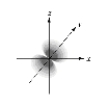
D)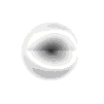
E)
A)

B)

C)

D)

E)


Unlock Deck
Unlock for access to all 65 flashcards in this deck.
Unlock Deck
k this deck
56
According to Heisenberg's _____ principle,it is impossible to simultaneously measure the exact location and energy of an electron.

Unlock Deck
Unlock for access to all 65 flashcards in this deck.
Unlock Deck
k this deck
57
Which of the following properties of orbital is associated with the value of the principal quantum number?
A) Number of electrons in an orbital
B) Size of an orbital
C) Orientation in space of an orbital
D) Energy of an orbital
E) Shape of an orbital
A) Number of electrons in an orbital
B) Size of an orbital
C) Orientation in space of an orbital
D) Energy of an orbital
E) Shape of an orbital

Unlock Deck
Unlock for access to all 65 flashcards in this deck.
Unlock Deck
k this deck
58
A point in a standing wave that has zero amplitude is called a(n)________.

Unlock Deck
Unlock for access to all 65 flashcards in this deck.
Unlock Deck
k this deck
59
Which of the following orbital boundary surfaces is a representation of a  orbital?
orbital?
A)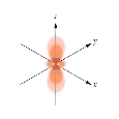
B)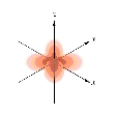
C)
D)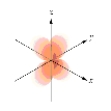
E)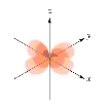
 orbital?
orbital?A)

B)

C)

D)

E)


Unlock Deck
Unlock for access to all 65 flashcards in this deck.
Unlock Deck
k this deck
60
Which of the following orbital boundary surfaces represent d-orbitals? 
A) 1 only
B) 3 only
C) 2 only
D) 1 and 2
E) 1 and 4

A) 1 only
B) 3 only
C) 2 only
D) 1 and 2
E) 1 and 4

Unlock Deck
Unlock for access to all 65 flashcards in this deck.
Unlock Deck
k this deck
61
The size of an electron orbital is often chosen to be the distance within which 90% of the electron density is found.Why is the orbital radius not chosen to be the distance within which 100% of the electron density is found?

Unlock Deck
Unlock for access to all 65 flashcards in this deck.
Unlock Deck
k this deck
62
Occupied states or energy levels in the hydrogen atom with n > 1 are called _____ states.

Unlock Deck
Unlock for access to all 65 flashcards in this deck.
Unlock Deck
k this deck
63
What evidence does the photoelectric effect provide that photons are not only waves?

Unlock Deck
Unlock for access to all 65 flashcards in this deck.
Unlock Deck
k this deck
64
The difference in energy between adjacent energy levels in an atom _____ as n increases.

Unlock Deck
Unlock for access to all 65 flashcards in this deck.
Unlock Deck
k this deck
65
Which of the following is the correct series of lines that have energies in visible region of the hydrogen spectrum?
A) Balmer series
B) Lyman series
C) Brackett series
D) Pfund series
E) Humphreys series
A) Balmer series
B) Lyman series
C) Brackett series
D) Pfund series
E) Humphreys series

Unlock Deck
Unlock for access to all 65 flashcards in this deck.
Unlock Deck
k this deck



